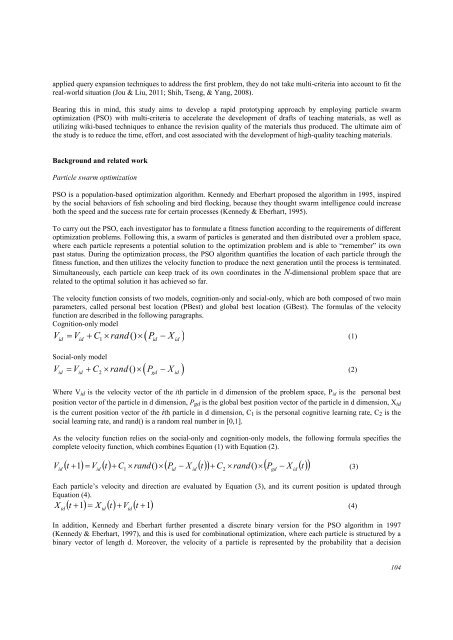Download Complete Issue in PDF - Educational Technology & Society
Download Complete Issue in PDF - Educational Technology & Society
Download Complete Issue in PDF - Educational Technology & Society
Create successful ePaper yourself
Turn your PDF publications into a flip-book with our unique Google optimized e-Paper software.
applied query expansion techniques to address the first problem, they do not take multi-criteria <strong>in</strong>to account to fit the<br />
real-world situation (Jou & Liu, 2011; Shih, Tseng, & Yang, 2008).<br />
Bear<strong>in</strong>g this <strong>in</strong> m<strong>in</strong>d, this study aims to develop a rapid prototyp<strong>in</strong>g approach by employ<strong>in</strong>g particle swarm<br />
optimization (PSO) with multi-criteria to accelerate the development of drafts of teach<strong>in</strong>g materials, as well as<br />
utiliz<strong>in</strong>g wiki-based techniques to enhance the revision quality of the materials thus produced. The ultimate aim of<br />
the study is to reduce the time, effort, and cost associated with the development of high-quality teach<strong>in</strong>g materials.<br />
Background and related work<br />
Particle swarm optimization<br />
PSO is a population-based optimization algorithm. Kennedy and Eberhart proposed the algorithm <strong>in</strong> 1995, <strong>in</strong>spired<br />
by the social behaviors of fish school<strong>in</strong>g and bird flock<strong>in</strong>g, because they thought swarm <strong>in</strong>telligence could <strong>in</strong>crease<br />
both the speed and the success rate for certa<strong>in</strong> processes (Kennedy & Eberhart, 1995).<br />
To carry out the PSO, each <strong>in</strong>vestigator has to formulate a fitness function accord<strong>in</strong>g to the requirements of different<br />
optimization problems. Follow<strong>in</strong>g this, a swarm of particles is generated and then distributed over a problem space,<br />
where each particle represents a potential solution to the optimization problem and is able to “remember” its own<br />
past status. Dur<strong>in</strong>g the optimization process, the PSO algorithm quantifies the location of each particle through the<br />
fitness function, and then utilizes the velocity function to produce the next generation until the process is term<strong>in</strong>ated.<br />
Simultaneously, each particle can keep track of its own coord<strong>in</strong>ates <strong>in</strong> the N-dimensional problem space that are<br />
related to the optimal solution it has achieved so far.<br />
The velocity function consists of two models, cognition-only and social-only, which are both composed of two ma<strong>in</strong><br />
parameters, called personal best location (PBest) and global best location (GBest). The formulas of the velocity<br />
function are described <strong>in</strong> the follow<strong>in</strong>g paragraphs.<br />
Cognition-only model<br />
(1)<br />
( )<br />
V = V + C × rand() × P − X<br />
id id 1<br />
id id<br />
Social-only model<br />
( )<br />
V = V + C × rand () × P − X<br />
id id 2<br />
gd id<br />
Where Vid is the velocity vector of the ith particle <strong>in</strong> d dimension of the problem space, Pid is the personal best<br />
position vector of the particle <strong>in</strong> d dimension, Pgd is the global best position vector of the particle <strong>in</strong> d dimension, Xid<br />
is the current position vector of the ith particle <strong>in</strong> d dimension, C1 is the personal cognitive learn<strong>in</strong>g rate, C2 is the<br />
social learn<strong>in</strong>g rate, and rand() is a random real number <strong>in</strong> [0,1].<br />
As the velocity function relies on the social-only and cognition-only models, the follow<strong>in</strong>g formula specifies the<br />
complete velocity function, which comb<strong>in</strong>es Equation (1) with Equation (2).<br />
( )<br />
( t + ) = V ( t)<br />
+ C × rand()<br />
× ( P − X ( t)<br />
) + C × rand()<br />
× P − X ( t)<br />
Vid 1 id 1 id id<br />
2<br />
gd id<br />
(3)<br />
Each particle’s velocity and direction are evaluated by Equation (3), and its current position is updated through<br />
Equation (4).<br />
(4)<br />
( t + 1 ) = X ( t)<br />
+ V ( t + 1)<br />
X id<br />
id id<br />
In addition, Kennedy and Eberhart further presented a discrete b<strong>in</strong>ary version for the PSO algorithm <strong>in</strong> 1997<br />
(Kennedy & Eberhart, 1997), and this is used for comb<strong>in</strong>ational optimization, where each particle is structured by a<br />
b<strong>in</strong>ary vector of length d. Moreover, the velocity of a particle is represented by the probability that a decision<br />
(2)<br />
104

















